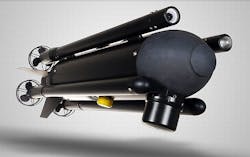Navy orders unmanned combat vehicles for littoral combat ship to find and kill ocean mines
Officials of the Naval Sea Systems Command in Washington placed an $11.2 million order last Thursday with Atlas North America LLC in Yorktown, Va., for SeaFox explosive and inert rounds, as well as an AN/SLQ-60 shipboard SeaFox control system for the LCS.
The Atlas SeaFox mine-disposal UUV is based on an expendable mine-disposal vehicle (EMDV). The semi-automatic UUV can detect and classify mines and other munitions concealed underwater to attack surface ships and submarines.
The UUV is guided by a fiber-optic cable, and can help with damage estimation, intelligence, route survey, maritime boundary control, and harbor surveillance. Atlas North America is a wholly owned subsidiary of ATLAS Elektronik GmbH of Bremen, Germany.
The system, which consists of a console, a launcher, and the SeaFox vehicles, can launch from naval minesweepers, surface warships, rubber boats, and from helicopters.
story continues below
SeaFox comes in four variants: a one-shot mine identification and disposal system; a mine identification, inspection, and training UUV; a training version; and one equipped with an explosive ordnance disposal tool.
The SeaFox UUV is about four feet long, one foot wide, and weighs about 95 pounds. The UUV uses a transponder- and responder-aided dead reckoning pressure sensor for navigation in the sea. The operator communicates with the SeaFox using a fiber-optic cable.
The vehicle includes four independent reversible motors and a hover thruster to maneuver, and powered by chargeable and non-rechargeable batteries. It can relocate previously detected underwater objects automatically within minutes with its homing sonar.
Related: Raytheon, Applied Physical Sciences to develop Navy unmanned mine-hunting technology
After relocating, the onboard CCTV camera identifies suspected mines and destroys them with a built-in large-caliber shaped charge.
The contract announced last week has options that could increase its value to $48.2 million. Atlas will do the work in Bremen, Germany; Panama City, Fla.; and Yorktown, Va., and should be finished by April 2017.
For more information contact Atlas North America online at /www.na.atlas-elektronik.com.
